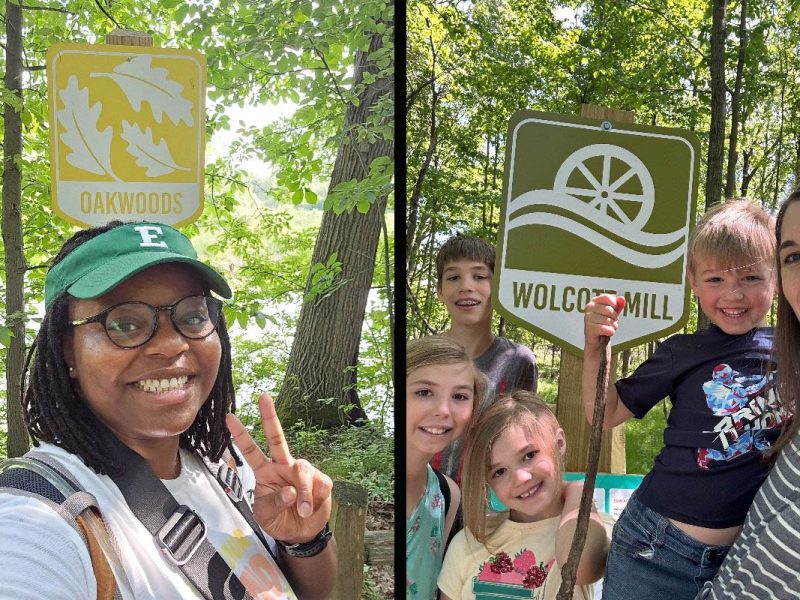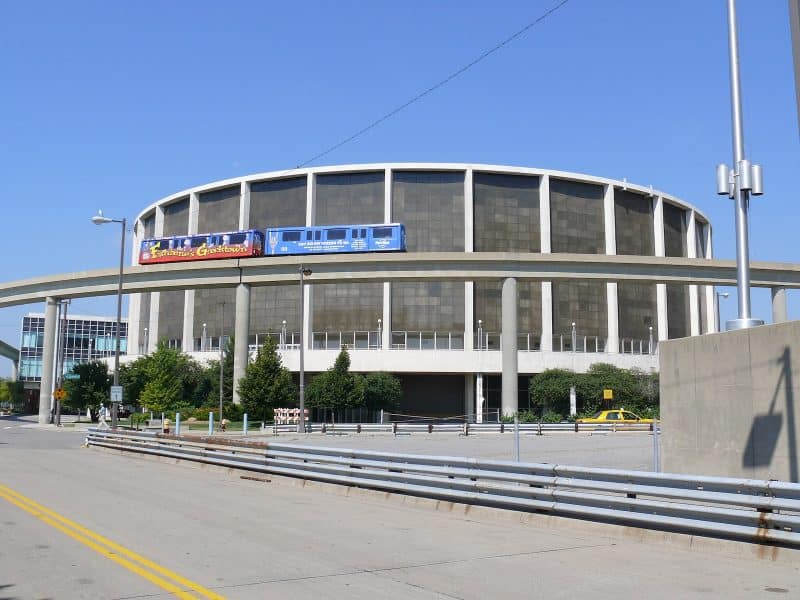Urban Exchange: Trading Ideas with Toronto
Model D's Claire Nelson and Hopscotch Detroit social innovator Ajooni Sethi go north to share the power of play as a tool for civic engagement with our Canadian comrades at Yonge St. Sounds like some serious fun was had in the Queen City.
If you’re a geek about cities, the best kind of email to appear in your inbox is an invitation to visit another one. Even better when it’s a place that you love — and better still when it’s an opportunity to share ideas for a better urban future.
So when the awesome folks at Yonge Street in Toronto kindly invited us to come participate in a cross-city dialogue, we didn’t think twice. “Of course! Oh, what’s the topic?”
As it turns out, our comrades to the north were interested in the power of “play” in civic engagement — a topic that is very much in our DNA, thanks to Model D co-founder Brian Boyle. His love for beer and bean bags helped set in motion the World’s Largest Cornhole Tournament™ in Roosevelt Park, which, in turn, inspired “PR for RP” — a clever conceit to engage his Pleasant Ridge neighbors in the transformation of the Corktown greenspace.
In this same spirit, Toronto is launching a new initiative called Playing for Keeps — a citywide program to promote community connectedness through outdoor recreation and creative activity. Why? Well, as Canada’s largest city gears up to host the 2015 Pan Am Games, the Toronto Community Foundation recognized an opportunity: How could they use the momentum of this major sporting event to create lasting connections between residents and neighborhoods?
Their answer: Set the stage for fun, and invite people to play.
The theory, of course, is that this fun will lead to meatier stuff — building social capital, cultivating future leaders, fostering a sense of belonging, promoting wellness — the kind of stuff that creates healthy communities.
Seems a sound proposition, yes? But for those of you who work in philanthropy, you can appreciate their creativity and courage in investing in a somewhat unorthodox strategy. Can street games and jump-rope really jump-start community change?
In Toronto, they’re betting on it — the same way modern workplaces are betting on foosball tables and happy hours to lubricate innovation. After all, sometimes our best inventions and collaborations are born not while staring at computer screens, but over beers at the bar or playing ball with friends.
It’s also a bet we’ve begun to see net results here in Detroit, with Detroit City Futbol League as one favorite example. Detroiters come out for the soccer, stay for the camaraderie (and rivalry) — and before you know it, they’re volunteering in their community and buying homes. As we’ve seen from Belle Isle to Fort Wayne, sport has proven a great “gateway drug” for city pride and connectivity, with leagues like DCFL bolstering neighborhood identity and service along the way. (Well played, Sean Mann.)
Another local example is Hopscotch Detroit — a community event that took place last September as part of the Detroit Design Festival. The invitation was seductively simple: come grab some chalk and hop along! No heavy commitment, no required experience, and anyone of any age could participate. The larger goals, of course, were much deeper: introduce neighbors, reclaim the sidewalks, and stitch together city blocks with a low-cost, high-impact design solution.
Hopscotch was also a perfect demonstration of the “Lighter, Quicker, Cheaper” placemaking approach promoted by the Project for Public Spaces — a concept that challenges the notion that we need piles of money to bring people together. With dwindling government resources for permanent infrastructure, we’re seeing a rise in more temporary and mobile interventions in cities — pop-up markets, food carts, design installations and more.
Plus, a little friendly competition doesn’t hurt — who doesn’t enjoy the challenge of breaking a world record? Hopscotch Detroit succeeded in setting a new one with its 3.75 mile course, beating out the previous record holder — a town in Ontario, ironically.
Our friends in Toronto were intrigued by this Hopscotch project — who was behind it and how did it work? So we took our ace Ajooni Sethi, one of the enthusiastic young organizers from Wedge Detroit, to share some of her learnings. (We also roped in Noah Stephens, the talented photographer behind The People of Detroit, whose images you see here.)
The conversation took place at the stunning new Daniels Spectrum cultural center in Regents Park. Attended by a diverse crowd of Torontonians, it was moderated by Peter MacLeod, principal of a very cool firm called Mass LBP. MacLeod is pioneering an innovative model for what they call “public consultation” — a sort of lottery system to invite citizens to help design public policy.
“Like jury duty?” I asked. “Yes,” he laughed, “but more coveted.”
He then produced a recently mailed invitation as proof — and yes, it was more enticing than a jury summons. (Man, these Canadians sure do take their civic engagement seriously.)
But hey, so do we Detroiters — and as predicted, Sethi wowed the crowd with her passion for community and the story of how her small, startup design collective engaged over a thousand residents on a shoestring budget, thanks to hours of sweat equity from eager volunteers. To help paint the picture, we filled the big screen with photos of Detroit kids drawing, adults laughing, and our personal favorite — the lovely Mollika Basu Biernat, 8 months pregnant, hopping like a pro — in heels, no less.
“This project didn’t change the world,” said Sethi. “But we did receive really amazing messages from people as faraway as Moscow.”
Touching even just that one person, according to the ambitious 22-year-old, was a legit measure of success. Not only did Hopscotch prove a great way for Sethi and her fellow University of Michigan graduates to introduce themselves to their new city, but also for Detroit to reintroduce itself to the world — as a place of creativity and imagination, even in the face of well-known challenges.
One of these challenges, as we all know, is fragmented communities — the consequence of decades of disinvestment, segregation and sprawl. While Detroit is taking major steps toward greater connectivity through new investments in transit and the recently-released framework for urban planning, many Detroiters have not been content to wait around for large-scale efforts to reconnect the dots. Instead, they do what they can with what they have.
These are the stories we’re telling through the Urban Innovation Exchange — innovators leading small-scale neighborhood impact, filling gaps in the physical and social fabric of the city.
The gaps we can see quite clearly in Detroit’s landscape aren’t quite as detectable to the naked eye in Toronto. Here, you can immediately see the density and feel the vitality — not in an overwhelming way, but in a Goldilocks “just right” kind of way.
At this moment, there are more cranes in the air in Toronto than anywhere in North America, signaling a desire for urban living that is also picking up steam in Detroit. And as you walk around downtown Toronto, you see all the visual cues of successful urbanism — not just skyscrapers rising, but rows of independent storefronts stretching for miles, and streetcars and sidewalks filled with people. Even on a frigid day in January.
You can also see multiculturalism on steroids — the kind that Sethi, who also works with Global Detroit, reminds us exists in metro-Detroit, as well — but not with the same concentration or proximity that makes it so immediately visible and accessible in Toronto. Indeed, the capital of Ontario is exceptionally global, with half of its population (1.2 million people) born outside of Canada — compared with less than 5 percent here in the City of Detroit.
We revelled in this plurality during our stay, enjoying delicious food from all over the world, as well as cross-cultural conversations with merchants, taxi-drivers and barflies on our journeys about town. We had all been to Toronto before, but this global vibe made a deep impression once again — leading Noah Stephens to ask the first question during the program’s Q&A:
“To me, Toronto feels like utopia,” he said, directing his comment to Rosalyn Morrison of the Community Foundation. “So why the need to launch this Playing for Keeps initiative here and now?”
It was a great question — one that Morrison answered adeptly. Yes, she said, Toronto’s ethnic diversity is one of its strengths, but there were signs of strains to come. The Foundation’s “Vital Signs” report, a study that monitors quality of life in the city, detected the beginnings of a disconnect — not so much between race, but class.
Turns out Toronto, even with (or perhaps because of) its success, is not immune to the same economic pressures New York, Detroit and really most North American cities are currently experiencing — a disappearing middle class. As a result, Toronto is seeing a rising polarization between low-income and high-income residents.
This finding concerned the Foundation, which set out to bridge the gap before it widened any further. In medicine, they would call this “preventative healthcare” — fostering good habits before you reach a crisis point, instead of waiting until it’s too late.
I admit, this long-term thinking and advance planning made me a bit envious. If only we had been sprung to action in the early stages of major population shifts in Detroit, might we have avoided some of the corrective heavy-lifting we’re doing now?
But wishful thinking isn’t of much use to anyone — smarter to learn how to do better next time. This was also a welcome reminder that all urban centers, even the booming ones, are grappling with similar challenges in different forms. Cities are constantly changing, and getting ahead of change with innovative solutions is part of our civic responsibility.
As with our own Speaker Series, many of the best conversations happen after the formal program wraps, and this occasion was no different. Guests went out of their way to invite us to their homes and offices, trading numbers and emails with promises to keep in touch.
One comment from a young woman in particular stayed with me (pardon my paraphrasing):
“You know, you might think Toronto is a utopia — and yeah, it’s great. But some of the cool things you guys are doing in Detroit would be a lot more difficult to pull off here. There’s more competition for attention and resources. It’s harder to do your own thing, find your audience, get noticed, and get permission because there’s already a lot going on. I think what you’re doing in Detroit is really exciting.”
And there it was, a nice reminder from a perfect stranger about the great opportunity we all have in Detroit. Sometimes you have to leave to remember why you stay. And sometimes, you have to pull your head up from your hyper-local focus to look around and learn.
In Detroit, we tend to resist comparisons with other cities — they’re different, we’re different, we don’t want to be just like Chicago or New York! But at the end of the day, there are some universal principles for making vibrant places, and finding common ground and sharing best practices benefits us all. Perhaps another city has solved a similar problem we’re currently tackling — or perhaps they’re tackling a similar problem right alongside us, just 200 miles away.
Let’s always keep learning and sharing — and having some fun while we’re at it.
Photos courtesy of Noah Stephens








